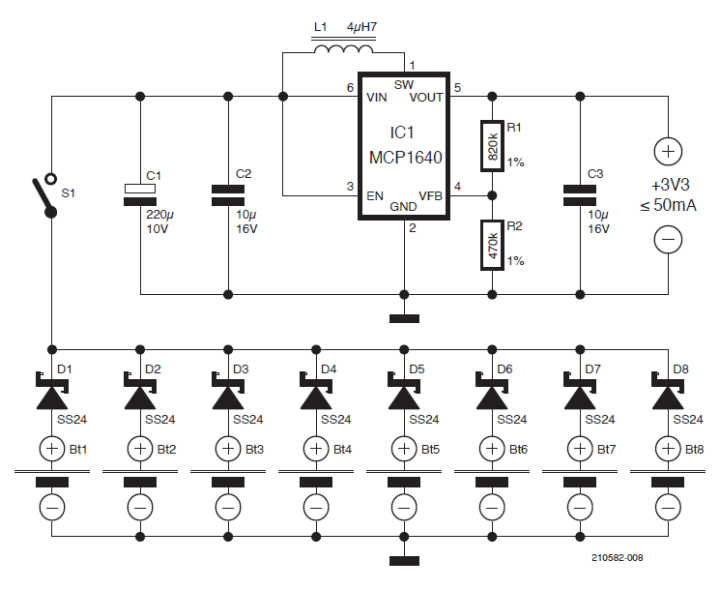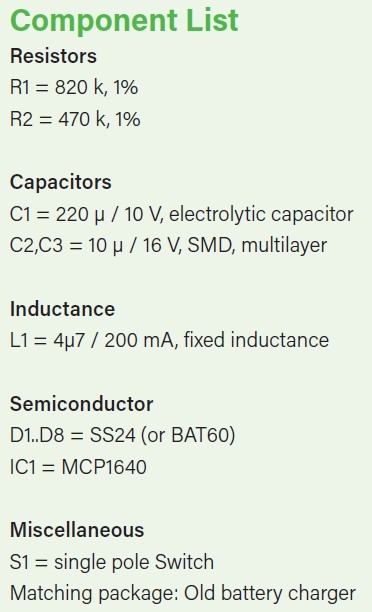Second Life for Batteries — Extracting Residual Energy
on
Over the course of time, mobile devices accumulate quite a few batteries, which then find their way in the collection boxes of supermarkets, etc. However, even apparently empty batteries can still contain amounts of residual energy! This is especially true for the much-used types like AA and AAA. Whether a battery is empty or not depends on how high the currents drawn are. At low loads with currents in the single-digit millamp range, batteries are pretty much sucked dry when the device operated with them fails to operate due to lack of energy. The residual voltage is then often less than 0.9 V in no-load operation — the criterion for whether a battery has really given up its last bit of energy.
In the case of heavier loads, such as in flashlights or motors in toys, the voltage of the battery breaks down due to its increasing power consumption. Voltage of the battery collapses earlier during operation due to its internal resistance, which increases with use. A battery change becomes due, although the battery voltage without load often reaches 1.3 V and more. Too bad, if these batteries were to be disposed of at this stage, wouldn’t it?
Energy Extractor
The above considerations led the author to build a circuit which extracts the residual energy of “old” batteries as much as possible. The principle is actually not very complicated. Take an efficient step-up converter of low power, which can also handle very low input voltages. In concrete terms, it uses its circuit to operate a normal small radio and a clock radio.
The circuit of Figure 1 shows the E3 (energy extractor electronics) in all its glory. There are eight batteries, which are connected by small Schottky diodes. The following MCP1640 step-up switching regulator turns the low input voltage into reliable 3.3 V — at least until the last battery has sent the last electron on its way via its electrodes.

The fact that eight batteries are quasi-parallel connected via diodes makes sense. The internal resistance of a single battery would quickly be too high, if it were loaded significantly. In parallel connection, however, the load on the individual battery is reduced, so that all of them can supply energy for longer. The voltage loss due to the diodes connected in series must be accepted, which is why for D1 … D8 Schottky diodes with the lowest possible forward voltage should be used.
The IC MCP1640 from Microchip is an inexpensive, small switching regulator for currents up to 350 mA, which can handle low input voltages to output voltages adjustable from 2 V to 5.5 V. Thanks to its low idle current of 19 µA, it is quite efficient even at low load currents. It still achieves efficiencies around 80% with input voltages below 0.9 V and a load of few 10 mA. Of course, the overall efficiency of the circuit also includes the loss via the diodes and with more than 60% over all should not be expected. But 60% of something that would otherwise have been wasted is much more than nothing.
Residual Battery Operation
Thanks to the diodes, of course the strongest battery is loaded the most at the beginning, and then the battery voltages gradually equalize. The diagram of Figure 2 shows a series of measurements to demonstrate that a small radio could be operated for a good eight weeks with one set of old batteries. During this time, the radio was in operation for an average of 105 minutes/day and required an average current of 35 mA. The fact that it is time to change the batteries can also be seen from the fact that the sound of the radio deteriorates as its power supply drops.

The radio would otherwise have been operated with a plug-in power supply, which consumes a power of 1.1 W. In operation, it even swallowed 3.5 W. In eight weeks, around 1.6 kWh would have been consumed. At about ¢50, the savings are economically limited, but still ecologically sensible.
Figure 3 shows the clock radio powered by used batteries thanks to E3. Interesting is the housing on the right: the electronics of a battery charger have simply been replaced by the E3. The spring contacts can hold eight AA or AAA cells — a very elegant solution. The more batteries are sucked out at the same time, the more residual energy they can supply.


About the Author
Lothar Göde completed an apprenticeship as a classical electrician, and in his free time, he dealt with electronics self-construction projects, which sometimes did not work. In order to better understand the circuits, he studied electronics. For several years, he has been working as a developer in the field of embedded software.
Questions or Comments?
If you have any technical questions, please feel free to contact the Elektor editorial team at editor@elektor.com.


Discussion (4 comments)